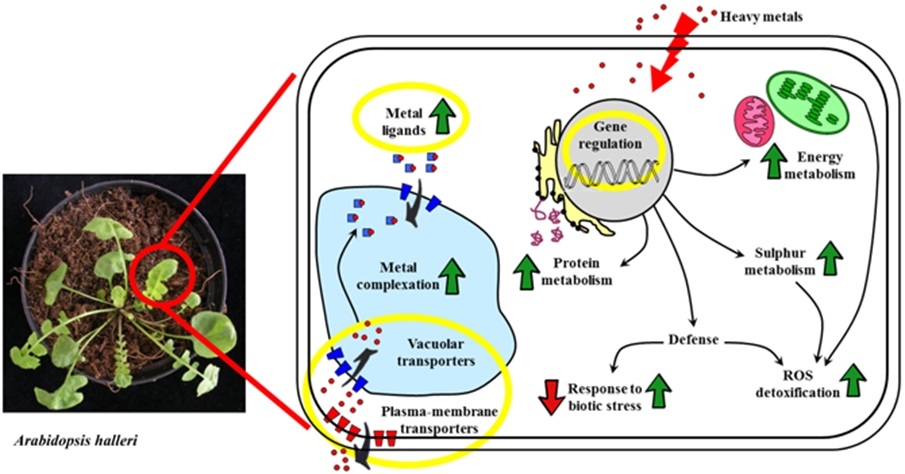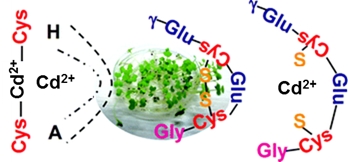
Amino Acids and their interactions with heavy metals
Natalia Cernei, Zbynyk Heger, Ondrej Zitka, Vojtech Adam, Rene Kizek
In this study we attempted to characterize amino acids properties and their possible interactions with the metal ions. In the first part of this study we described the structure of amino acids, its biochemical properties and its role in organism. In the next and the most important part we summarized accessible information about the metals and heavy metals which can form a bond with amino acids. Especially the heavy metals could have really important role in the process of metabolisms of amino acids, but this role is still unknown.

Fig. 1: Scheme of heavy metal detoxification in a plant cell

Fig. 2: Scheme of Cd2+ + PC2 via -SS- bridge
1. Mahadevan, R.; Bond, D.R.; Butler, J.E.; Esteve-Nunez, A.; Coppi, M.V.; Palsson, B.O.; Schilling, C.H.; Lovley, D.R. Characterization of metabolism in the Fe(III)-reducing organism Geobacter sulfurreducens by constraint-based modeling. Appl Environ Microbiol. 2006, 72, 1558-1568.
2. Silver, S.; Phung, L.T. Bacterial heavy metal resistance: New surprises. Annual Review of Microbiology. 1996, 50, 753-789.
3. Hall, J.L. Cellular mechanisms for heavy metal detoxification and tolerance. J Exp Bot. 2002, 53, 1-11.
4. Toohey, J.I. Sulfur Amino Acids in Diet-induced Fatty Liver: A New Perspective Based on Recent Findings. Molecules. 2014, 19, 8334-8349.
5. Giles, N.M.; Giles, G.I.; Jacob, C. Multiple roles of cysteine in biocatalysis. Biochem Biophys Res Commun. 2003, 300, 1-4.
6. Zenk, M.H.; Juenger, M. Evolution and current status of the phytochemistry of nitrogenous compounds. Phytochemistry. 2007, 68, 2757-2772.
7. Bridges, C.C.; Zalups, R.K. Homocysteine, system b0,+ and the renal epithelial transport and toxicity of inorganic mercury. Am J Pathol. 2004, 165, 1385-1394.
8. Appleton, T.G.; Hall, J.R.; Prenzler, P.D.; Ross, F.B. Complexes of Peptides and related molecules with diammine Platinum-II moldels for platinum protein interactions. Anti-Cancer Drug Design. 1991, 6, 262-263.
9. Pokrovsky, O.S.; Martinez, R.E.; Golubev, S.V.; Kompantseva, E.I.; Shirokova, L.S. Adsorption of metals and protons on Gloeocapsa sp cyanobacteria: A surface speciation approach. Applied Geochemistry. 2008, 23, 2574-2588.
10. Zoroddu, M.A.; Medici, S.; Peana, M.; Kowalik-Jankowska, T.; Kozlowski, H. Interaction of Cap43 Protein Fragments with Ni(II) and Cu(II), Medimond S R L, 40128 Bologna, 2008.
11. Hoyau, S.; Ohanessian, G. Interaction of alkali metal cations (Li+-Cs+) with glycine in the gas phase: A theoretical study. Chemistry-a European Journal. 1998, 4, 1561-1569.
12. Noctor, G.; Queval, G.; Mhamdi, A.; Chaouch, S.; Foyer, C.H. Glutathione. Arabidopsis Book. 2011, 9, 18.
13. Cobbett, C.S. Phytochelatins and their roles in heavy metal detoxification. Plant Physiol. 2000, 123, 825-832.
14. Chen, R.; Ren, S.; Meng, T.; Aguilar, J.; Sun, Y. Impact of glutathione-S-transferases (GST) polymorphisms and hypermethylation of relevant genes on risk of prostate cancer biochemical recurrence: a meta-analysis. PLoS One. 2013, 8.
J.Met.Nano:
volume-1, issue-3
- Personal and professional representation of the nanolabsys project
- Administration and information system of the project
- Microwave preparation of carbon quantum dots with different surface modification
- Cell lines as a model system for quantum dots applications
- Application of quantum dots into chicken embryos
- The influence of zinc to living organisms
- The influence of cadmium to living organisms
- The influence of lead to living organisms
- The influence of mercury to living organisms
- Monitoring of metallothionein levels in biological organism exposed to the metal elements and compounds
- The ratio of GSH/GSSG in biological organisms
- Amino Acids and their interactions with heavy metals
- Antioxidat enzymes – biochemical markers of oxidative stress
- Study of the interaction of quantum dots with tumor cells by fluorescence microscopy
- Flow-cytometric analysis of programmed cell death
- Bacteriophage λ as a doxorubicin nanocarrier
 PDF
PDF